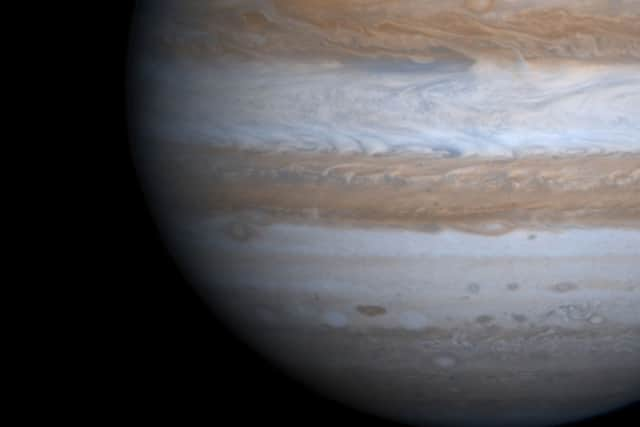How to see Jupiter’s closest approach in Glasgow - Met Office weather forecast for tonight’s spectacle
and live on Freeview channel 276
Extraordinary views of Jupiter are on the cards this week, according to space experts NASA, as the gas giant makes its closest approach to earth in the last 59 years.
The oldest planet in the solar system is due to ‘reach opposition’ on Monday (September 26) which is when, as Jupiter rises in the east, the sun is setting in the west - putting them at opposite sides of Earth.
Advertisement
Hide AdAdvertisement
Hide AdThis positioning will make the largest planet in the solar system appear bigger and brighter in the night sky.
This opposition does occur every 13 months but, because the planets do not orbit the sun in perfect circles, they pass each other at varying distances so it’s rare for Jupiter to be so near Earth.
Tonight will see the fifth planet from the sun come closer to earth than it has done in almost six decades - a distance of just 367 million miles away.
Although that still seems quite a stretch, to put it into perspective, at its farthest point it can be as much as 600 million miles away.
How to see Jupiter’s close approach to earth
Advertisement
Hide AdAdvertisement
Hide AdThe best spot for getting a good view of the celestial phenomenon is somewhere high, dark and dry, according to NASA experts.
Some of the highest points in and around Glasgow are:
- Cathkin Braes Country Park
- Mitchell Hill
- Netherton Braes Park
- Roundtree Hill
- Whitehill
- Sighthill
- Bartons Hill
- Balgray Hill
When you have found your ideal location, look to the eastern horizon around sunset.
You should be able to see the planet with the naked eye - Jupiter is likely to appear as the brightest object in the sky, aside from the moon.
Research astrophysicist at NASA’s Marshall Space Flight Center, Adam Kobelski, said: “With good binoculars, the banding (at least the central band) and three or four of the Galilean satellites (moons) should be visible.
Advertisement
Hide AdAdvertisement
Hide Ad“It’s important to remember that Galileo observed these moons with 17th century optics. One of the key needs will be a stable mount for whatever system you use.”
For enhanced visibility though, Kobelski recommends using a four-inch telescope or bigger, with filters in the green to blue range. This would mean you can see things such as Jupiter’s Great Red Spot and the bands in more detail.


When can you see Jupiter at its closest?
Although Monday will see the approach at its peak, the days surrounding that date will also show Jupiter at close quarters too.
So if you are unable to go out stargazing tomorrow, or the weather doesn’t allow for good visibility, you should still get a good view for the rest of the week.
Will you be able to see Jupiter in Glasgow?
Advertisement
Hide AdAdvertisement
Hide AdTonight’s sky will be partly cloudy in Glasgow, according to the Met Office’s forecast, so you may have difficulty seeing Jupiter clearly.
However, tomorrow is meant to be a clear night after 8pm, so that might be the best time to try to see the planet.
Wednesday is forecast to be cloudy so perhaps not the best time to go star-gazing.
Comment Guidelines
National World encourages reader discussion on our stories. User feedback, insights and back-and-forth exchanges add a rich layer of context to reporting. Please review our Community Guidelines before commenting.
